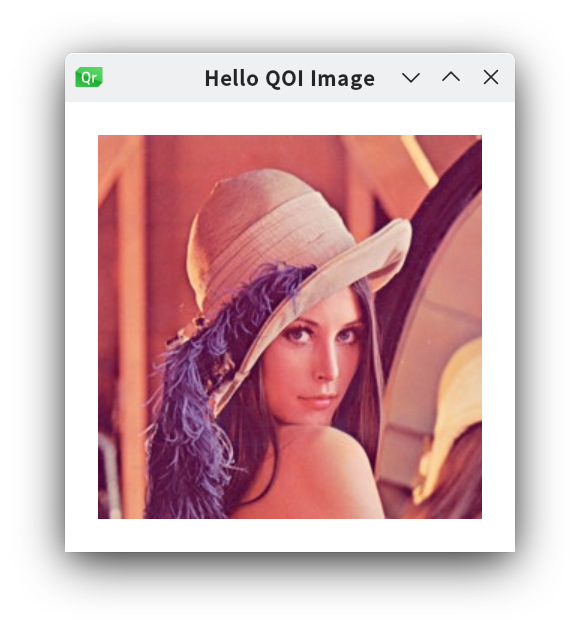はじめに
この記事は Qt Advent Calendar 2021 3日目の記事です。
昨日は、@phyblas さんの PyQtのドラッグ&ドロップの使い方 という大作でした。様々な形で使うことができるんですね。
今日は QOI について書きたいと思います。
Quite OK Image とは
11/24 に発表された、なぜか速い画像の可逆圧縮コードです。
日本語はこちらがわかりやすいです。
Qt で対応している画像の形式
Qt では標準で以下の画像の形式に対応しています。
| Format | Description | Qt's support |
|---|---|---|
| BMP | Windows Bitmap | Read/write |
| GIF | Graphic Interchange Format (optional) | Read |
| JPG | Joint Photographic Experts Group | Read/write |
| JPEG | Joint Photographic Experts Group | Read/write |
| PNG | Portable Network Graphics | Read/write |
| PBM | Portable Bitmap | Read |
| PGM | Portable Graymap | Read |
| PPM | Portable Pixmap | Read/write |
| XBM | X11 Bitmap | Read/write |
| XPM | X11 Pixmap | Read/write |
ドキュメント: Reading and Writing Image Files
それから、Qt SVG モジュールを利用することで、SVG 形式の画像を扱うことができます。
さらに、Qt Image Format というアドオンのモジュールを利用することで、以下の画像形式にも対応可能です。
| Format | Description | Support | 3rd Party Codec |
|---|---|---|---|
| ICNS | Apple Icon Image | Read/write | No |
| JP2 | Joint Photographic Experts Group 2000 | Read/write | Yes (Not bundled) |
| MNG | Multiple-image Network Graphics | Read | Yes (Not bundled) |
| TGA | Truevision Graphics Adapter | Read | No |
| TIFF | Tagged Image File Format | Read/write | Yes (bundled) |
| WBMP | Wireless Bitmap | Read/write | No |
| WEBP | WebP | Read/write | Yes (bundled) |
ドキュメント: The Image I/O Plugins
Qt で画像の形式を追加する方法
Qt では画像の形式を プラグイン で実装しており、独自の拡張も簡単になっています。
実際には QImageIOPlugin に対応したプラグインを作成する必要があります。
QtQOIImagePlugin の作成
プロジェクトファイル
TEMPLATE = lib
QT = gui
CONFIG += plugin
DEFINES += QOI_NO_STDIO
SOURCES += \
qqoiimageioplugin.cpp
HEADERS += \
qqoiimageioplugin.h \
qio.h
DISTFILES += QtQOIImagePlugin.json
# Default rules for deployment.
unix {
target.path = $$[QT_INSTALL_PLUGINS]/imageformats
}
!isEmpty(target.path): INSTALLS += target
Qt Creator でプラグインを作成し、適当にアップデートしました。
JSON ファイル
{
"Keys" : [ "qoi" ]
}
これもまぁテンプレですね。
ヘッダファイル
# ifndef QQOIIMAGEIOPLUGIN_H
# define QQOIIMAGEIOPLUGIN_H
# include <QtGui/QImageIOPlugin>
class QQOIImageIOPlugin : public QImageIOPlugin
{
Q_OBJECT
Q_PLUGIN_METADATA(IID QImageIOHandlerFactoryInterface_iid FILE "QtQOIImagePlugin.json")
public:
explicit QQOIImageIOPlugin(QObject *parent = nullptr);
QImageIOPlugin::Capabilities capabilities(QIODevice *device, const QByteArray &format) const override;
QImageIOHandler *create(QIODevice *device, const QByteArray &format) const override;
};
# endif // QQOIIMAGEIOPLUGIN_H
これも、シンプルに QImageIOPlugin のサブクラスを作成し、必要なメソッドをオーバーライドしています。
qio.h
e9069e11a43d779b418679c7a50b2ec14f652085 のものを利用しました。
ソースファイル
# include "qqoiimageioplugin.h"
# define QOI_IMPLEMENTATION
# define QOI_MALLOC(sz) (unsigned char *)malloc(sz)
# define QOI_FREE(p) (unsigned char *)free(p)
# include "qio.h"
# include <QtCore/QDebug>
class QQOIImageIOHandler : public QImageIOHandler
{
public:
bool canRead() const override;
bool read(QImage *image) override;
};
bool QQOIImageIOHandler::canRead() const
{
if (!device())
return false;
return device()->bytesAvailable() > 0;
}
bool QQOIImageIOHandler::read(QImage *image)
{
auto data = device()->readAll();
int size = data.length();
qoi_desc spec {};
void *decoded = qoi_decode(data.constData(), size, &spec, 4);
if (!decoded)
return false;
*image = QImage(spec.width, spec.height, QImage::Format_ARGB32);
auto p = static_cast<unsigned char *>(decoded);
for (unsigned int y = 0; y < spec.height; y++) {
auto *l = reinterpret_cast<unsigned int *>(image->scanLine(y));
for (unsigned int x = 0; x < spec.width; x++) {
const auto r = *p++;
const auto g = *p++;
const auto b = *p++;
const auto a = *p++;
*l++ = qRgba(r, g, b, a);
}
}
free(decoded);
return true;
}
QQOIImageIOPlugin::QQOIImageIOPlugin(QObject *parent)
: QImageIOPlugin(parent)
{}
QImageIOPlugin::Capabilities QQOIImageIOPlugin::capabilities(QIODevice *device, const QByteArray &format) const
{
QImageIOPlugin::Capabilities ret;
if (format == "qoi") {
if (device) {
if (device->isReadable())
ret |= QImageIOPlugin::CanRead;
} else {
ret |= QImageIOPlugin::CanRead;
}
}
return ret;
}
QImageIOHandler *QQOIImageIOPlugin::create(QIODevice *device, const QByteArray &format) const
{
auto ret = new QQOIImageIOHandler;
ret->setDevice(device);
ret->setFormat(format);
return ret;
}
特に、説明するような凝ったことはしていなくて、
QOI 向けの QImageIOHandler のサブクラスを実装し、QImagePlugin の create 関数で返しています。
実行
Qt で画像を表示するさいに、QGraphicsView を利用する方が結構多いみたいですが、
シンプルなケースでは、QLabel で十分です。
今回は Qt Quick で画像を表示してみましょう。
import QtQuick
import QtQuick.Window
Window {
width: 300
height: 300
visible: true
title: qsTr("Hello QOI Image")
Image {
anchors.centerIn: parent
source: 'len_std.qoi'
}
}
おわりに
今回のソースコードは https://github.com/task-jp/qtqoiimageplugin で公開しています。
ぜひお試しください!
明日は @task-jp さんの「Qt にバグ報告をして直してもらった感じのことを書きます」です。お楽しみに!
